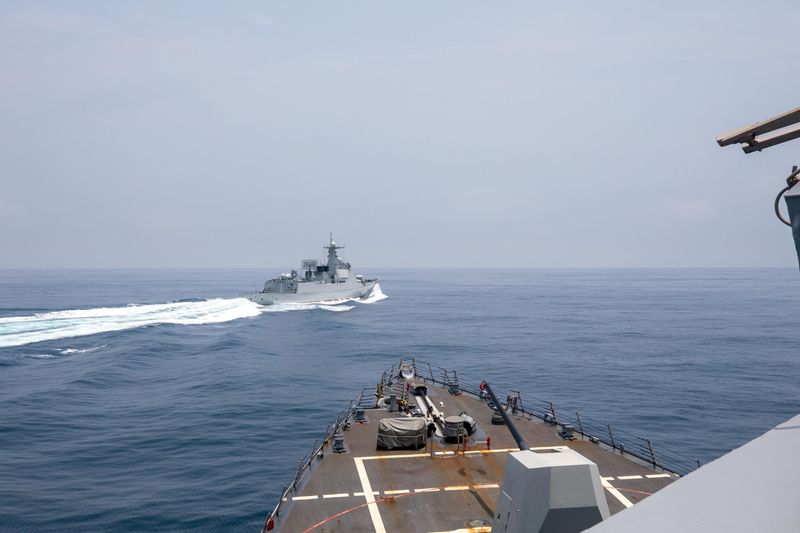Explainer-Why dangerous encounters by US and Chinese militaries look set to continue
2023.06.06 02:18

© Reuters. FILE PHOTO: Chinese warship Luyang III sails near the U.S. destroyer USS Chung-Hoon, as seen from the deck of U.S. destroyer, in the Taiwan Strait, June 3, 2023, in this handout picture. U.S. Navy/Mass Communication Specialist 1st Class Andre T. Richard/H
By Michael Martina and Martin Quin Pollard
WASHINGTON/BEIJING (Reuters) – When a Chinese warship came within 150 yards of a U.S. destroyer in the Taiwan Strait on Saturday and forced it to slow down, it was the second time in a matter of days in which Chinese and U.S. military personnel came close to a major incident.
Late last month a Chinese fighter jet flew in front of a U.S. warplane over the South China Sea, drawing a rebuke from the United States.
After the warship encounter on Saturday, the White House accused China of “growing aggressiveness”. China has said that such U.S. military activity in international waters is “deliberately provoking risk.”
Here is why these recent close encounters between the U.S. and Chinese militaries may continue:
CHINA PUSHING BACK
Under President Xi Jinping, China has embarked on what U.S. officials say is one of the largest peacetime military buildups in history.
Beijing is using its growing military capability and economic clout to push back on decades-old U.S. military dominance in Asia. China regards the United States as an outsider interfering in a region in which it sees itself as a force for peace and stability.
A particular source of tension are the “freedom of navigation” patrols in which the United States and its allies sail naval vessels through the Taiwan Strait and the South China Sea.
The United States says such patrols defend the right of all countries to sail in international waters.
China has complained about U.S. vessels and aircraft in the Taiwan Strait and in the South China Sea close to islands it controls, claims, or constructed and turned into military installations. The People’s Liberation Army Navy (PLAN) typically trails the U.S. vessels.
Some analysts say Chinese military commanders have been encouraged to act more assertively against foreign military ships and planes.
“I think what we are seeing is likely a general encouragement, maybe even incentive scheme for (PLA) unit commanders to be aggressive when the opportunity presents, which is at the unit level encouraging more reckless behaviour,” said Jennifer Parker, a defence expert at the Australian Strategic Policy Institute.
Other recent incidents in the South China Sea have seen a Chinese coast guard ship direct a “military-grade laser” at a Philippines vessel in February, and Vietnam last month demand Beijing remove survey vessels from its waters.
China said both incidents were lawful and normal.
Its defence ministry did not immediately have comment on the assertion it was encouraging more aggressive behaviour.
This approach from the PLA increases the chances of a collision, which could spiral into armed conflict, says Derek Grossman, senior defence analyst at the RAND Corporation, a U.S. think tank.
“In my view, this is the no. 1 scenario that leads the U.S. and China to war, and less so Beijing seizing a feature in the disputed South China Sea or attacking Taiwan,” he said.
ON A COLLISION COURSE?
Making the situation more dangerous are the starkly different views of the U.S. and China about the source of the problem. The United States sees China as disrupting the status quo with its threats against Taiwan, the self-governed island that China claims as its own, and its territorial claims to the resource-rich South China Sea.
The answer from the U.S. perspective is to continue asserting its right to sail and fly near China.
China’s ruling Communist Party sees those U.S. actions as provocative and believes U.S. pursuit of military dominance is the real cause of the dangers in the region, said Tong Zhao, a visiting scholar at Princeton University’s School of Public and International Affairs.
“Chinese officials generally don’t see China’s own behaviours contributing to risks,” he said.
“And therefore their logic is China can only reduce the risk by stepping up its military measures to confront the U.S.’s aggressive behaviours, and to make the United States really feel concerned about incidents. And that’s when the United States would eventually take the necessary measures to reduce the risk.”
NO COMMUNICATION
Add to this one other problem: the lack of reliable communication channels between the two militaries.
The U.S. military has long pushed China for open lines of communication with the PLA – both at senior and lower levels – to mitigate the risk that accidents become military flare-ups.
China’s leaders, by contrast, have been slow to establish military contacts and quick to shut them down during periods of diplomatic tension, U.S. officials say.
China suspended several high-level military dialogues with the Pentagon after former U.S. House speaker Nancy Pelosi’s visit to Taiwan last summer and declined a U.S. request for a phone call between the two countries’ defence chiefs after the downing of Chinese spy balloon in U.S. airspace this year.
A senior U.S. defence official, speaking on the condition of anonymity, told Reuters that since 2021 China had declined or not responded to more than a dozen requests to talk with the Pentagon and nearly ten working-level engagement requests.
China’s defence ministry did not immediately respond to Reuters’ requests for comment.
Analysts say that China is wary of military talks that could give the United States greater insight into PLA operations. Chinese leaders would also prefer to keep U.S.-China discussions focused on trade and economic issues.
The dangers are not hypothetical, however.
In 2001 a U.S. spy plane made an emergency landing on Hainan island after a collision with a Chinese fighter jet.
One Chinese pilot died and Beijing detained the 24-member U.S. crew for 11 days, releasing them only after Washington sent a letter saying it was “very sorry.”








